Lille achieved the improbable in 2020/21 when they finished one point and one place above Paris Saint-Germain in the Ligue 1 table to win their fourth-ever Ligue 1 title, 10 years after winning their third. This title win made Lille the second-most successful side in France’s top-flight since the end of Lyon’s period of dominance in the 2000s, as they became the only team other than PSG to win more than one league title in that time.
This season, however, Les Dogues crashed back to reality as they disappointingly ended the 2021/22 campaign in 10th place, a long way off the heights they reached a year ago. The end of this season also marks the end of the road in Hauts-de-France for 2020/21 hero Burak Yılmaz, central midfielder Xeka and backup right-back Jérémy Pied, all of whom will require replacing this summer in one way or another.
This tactical analysis piece and team-focused scout report aims to look into how Lille may use this summer to improve their squad for next season when they’ll surely be looking to rejoin the race for UEFA Champions League football in France’s top flight. It’d be unrealistic to expect them to get back to challenging for the title, but the Champions League race is achievable. This scout report won’t be a recruitment analysis where we look for different options Lille could consider for key positions, though that would be a valuable analysis to conduct separately. Rather, this piece aims to look at Lille’s squad from the 2021/22 season, assess their style of play, requirements, strengths and weaknesses, along with taking the aforementioned departures into account, to highlight initial areas of concern and priority for Lille this summer.
So, how will we structure this analysis? We’ll split the piece into sections divided based on areas of the pitch. Then, we’ll look into specific demands for the positions we’re focusing on based on Lille’s playing style and tactics to identify what key characteristics and traits Les Dogues need to look for in their recruitment search. I’ll share one name for each position I’ve chosen to look into as a basic example of the kind of player I believe Lille may benefit from but, again, as previously mentioned, this isn’t an in-depth recruitment analysis to narrow down the absolute best options available. With that said, all that’s left to do is confirm that all stats, data and images used in this scout report have come from Wyscout unless otherwise stated.
Backline
The first section of this analysis will focus on Lille’s backline. With Lille primarily utilising a 4-4-2 system this term, their most-common backline has consisted of Mehmet Zeki Çelik at right-back, José Fonte at right centre-back, Sven Botman at left centre-back (with Tiago Djaló providing admirable cover last term) and Gabriel Gudmundsson at left-back. You could make a very strong case for Lille requiring two new first-team additions (be that via the transfer market or the club’s youth academy) in the backline next season — one at centre-back and one at right-back — due to Fonte playing as many league games as he has lived years (38) last season and right-back Pied departing the club, so this is an area where Lille may need to put plenty of their focus, even before thinking about potential departures (which we’ll not address in this scout report due to the speculative nature of that kind of discussion at this moment).
Lille conceded 46.66 xG this season compared to 29.68 in their title-winning campaign the season before while they conceded 48 goals compared to 23 the season before. For sure, AC Milan stopper Mike Maignan — who won Serie A this season having won Ligue 1 the season before — played a big part in his side’s impressive defence in 2020/21 as he is an excellent goalkeeper but it’s clear from the xG numbers that Lille’s overall defending and ability to stop the opposition from creating chances took a hit in 2021/22 — likely due to several reasons including the departure of Christophe Galtier for Nice, with Jocelyn Gourvennec taking his place in the Lille dugout.
Lille have maintained a similar structure to the one they used under Galtier, but it would appear as though Gourvennec wants his side to press a bit more aggressively than his predecessor did, with Lille’s wingers often sitting higher now than they did in the previous campaign under Galtier.
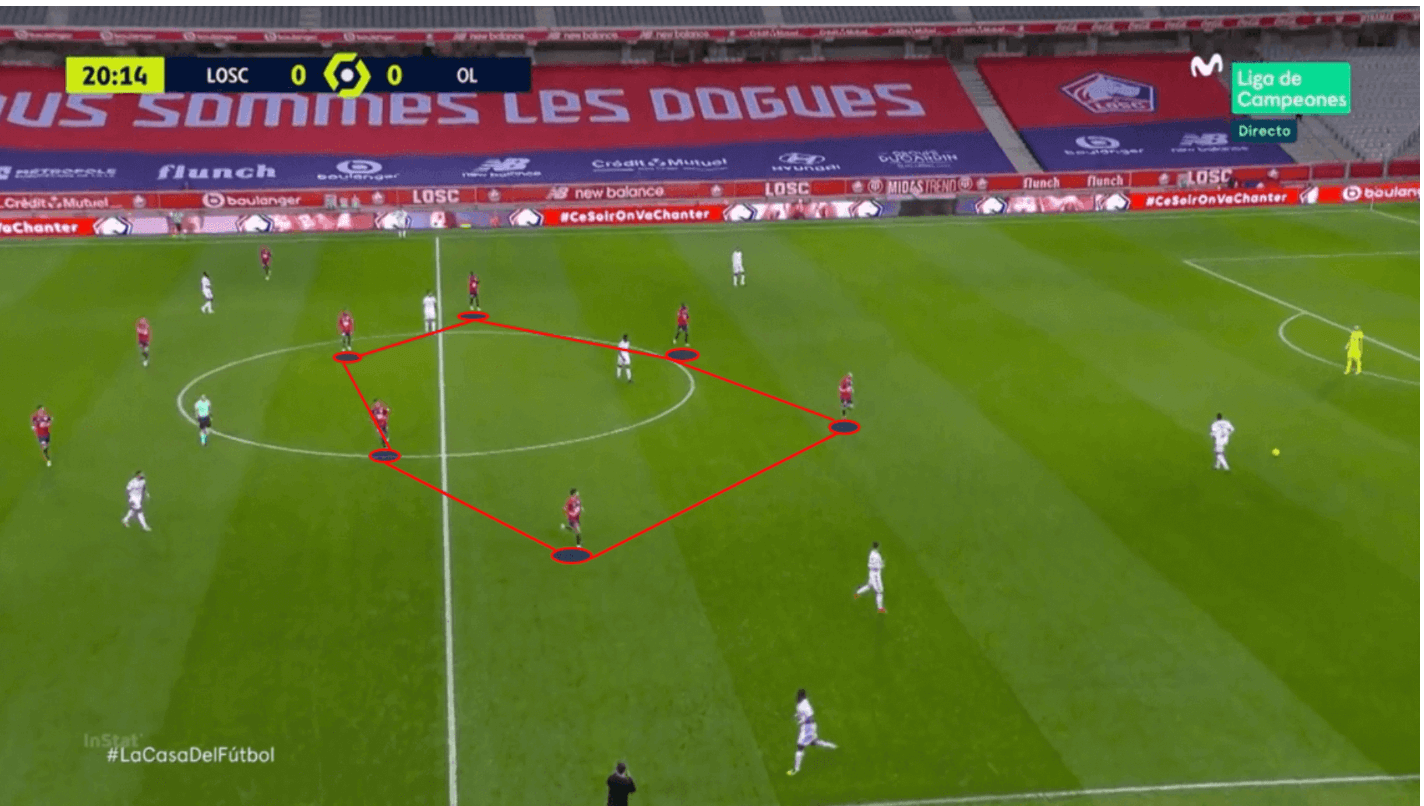
Figure 1 shows a typical example of Lille’s defensive shape from 2020/21. The centre-forwards didn’t tend to press the opposition’s centre-backs very aggressively, instead, sitting off and focused more on blocking the passing lanes into midfield. Meanwhile, the wingers remained very compact with the midfield, taking up narrow positions on either side of the central midfielders to form a hexagon around the midfield. Galtier’s beautiful mid-block and defensive organisation were key to Lille’s success in 2020/21 and remain key to his philosophy.
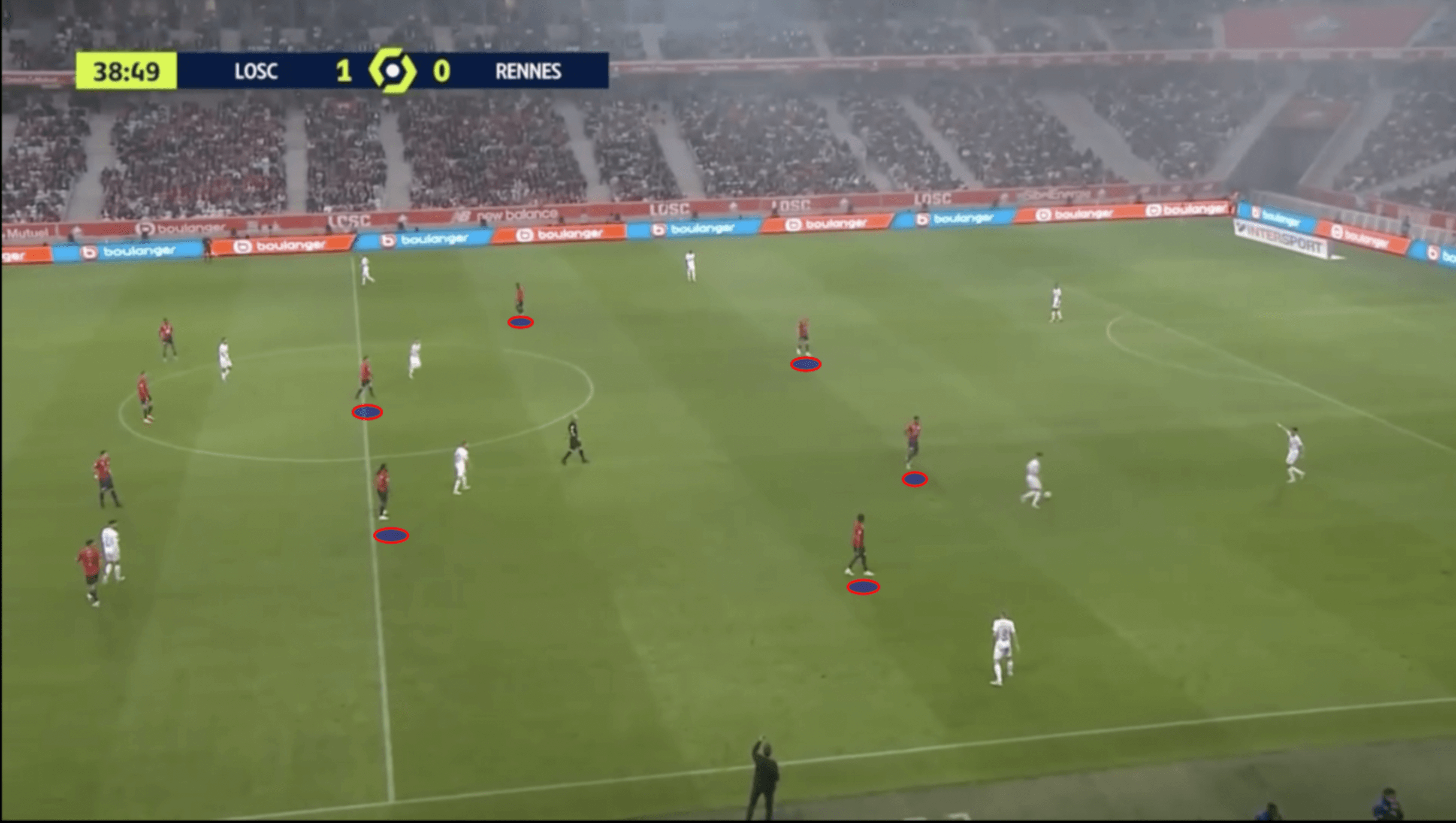
Moving into figure 2, from this season, we see the ball in a fairly similar area of the pitch though a little higher and with the holding midfielder rather than the centre-backs. Lille got pulled apart a little bit more easily in 2021/22 which can be seen in these images. Now, these are just two examples and aren’t 100% representative of the team’s setup and how it’s developed throughout the last two seasons, of course. However, go and watch the evolution yourself and you’ll see how Lille have gradually become more open in midfield which has coincided with Gourvennec’s apparent attempts to win the ball a little bit more proactively than his predecessor (which is perhaps one contributing factor to Lille’s PPDA falling from 12.39 last season (eighth-lowest) to 11.06 this season (fifth-lowest). This has also seen the wingers pressing earlier and more aggressively than they did the last term, which can result in high turnovers but can also result in the central midfielders becoming isolated.
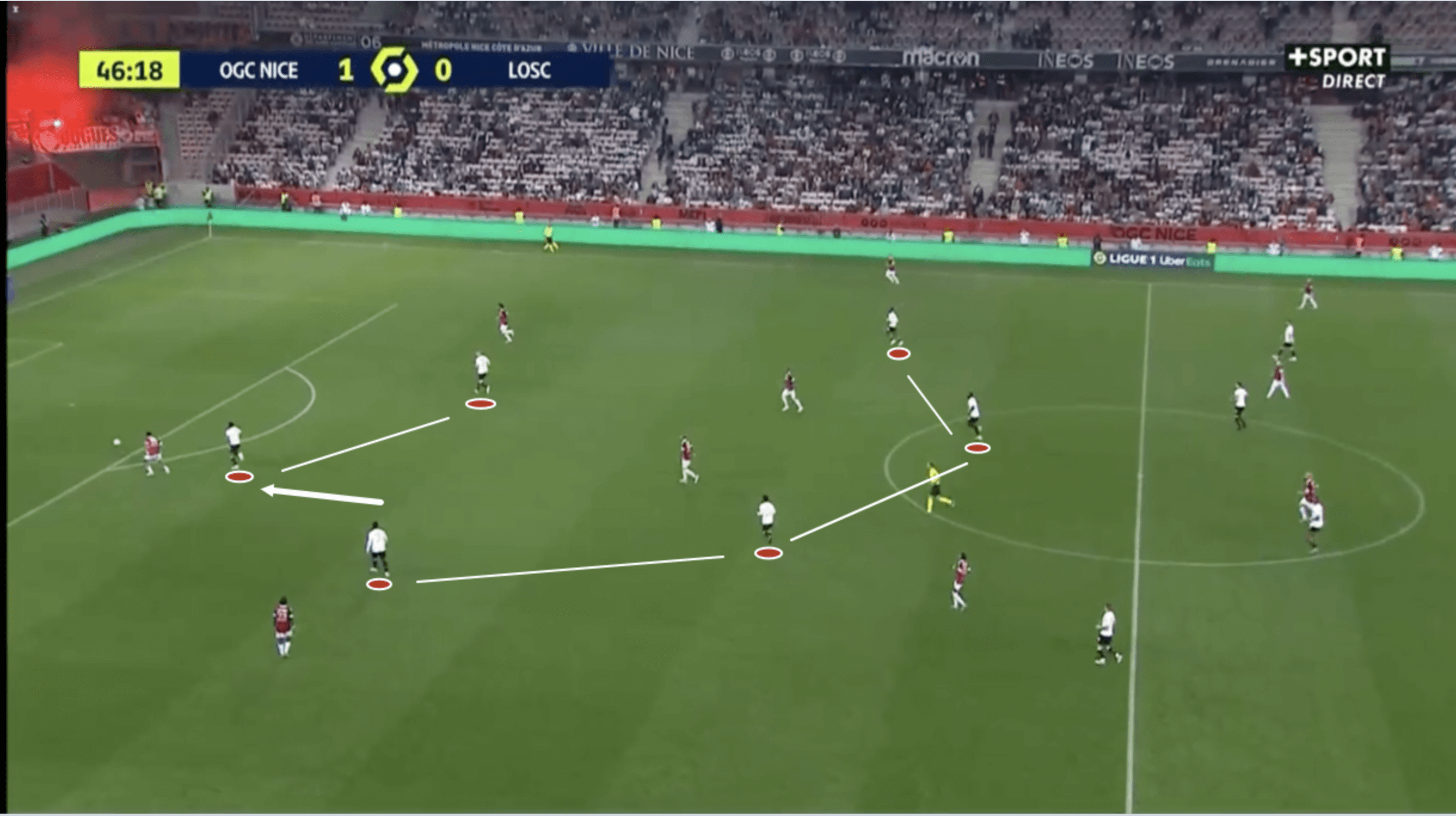
We see another example of Lille’s increased aggression this season in figure 3. Here, we see the centre-forwards pressing the backline aggressively — something that was far rarer last season — while the ball-near winger has again jumped early and aggressively. This creates a very different shape to the organised, rather passive central hexagon we became accustomed to seeing from Lille in their title-winning campaign, with the shape almost turning into a lopsided 4-3-3 depending on which side of the pitch the ball is located at that moment.
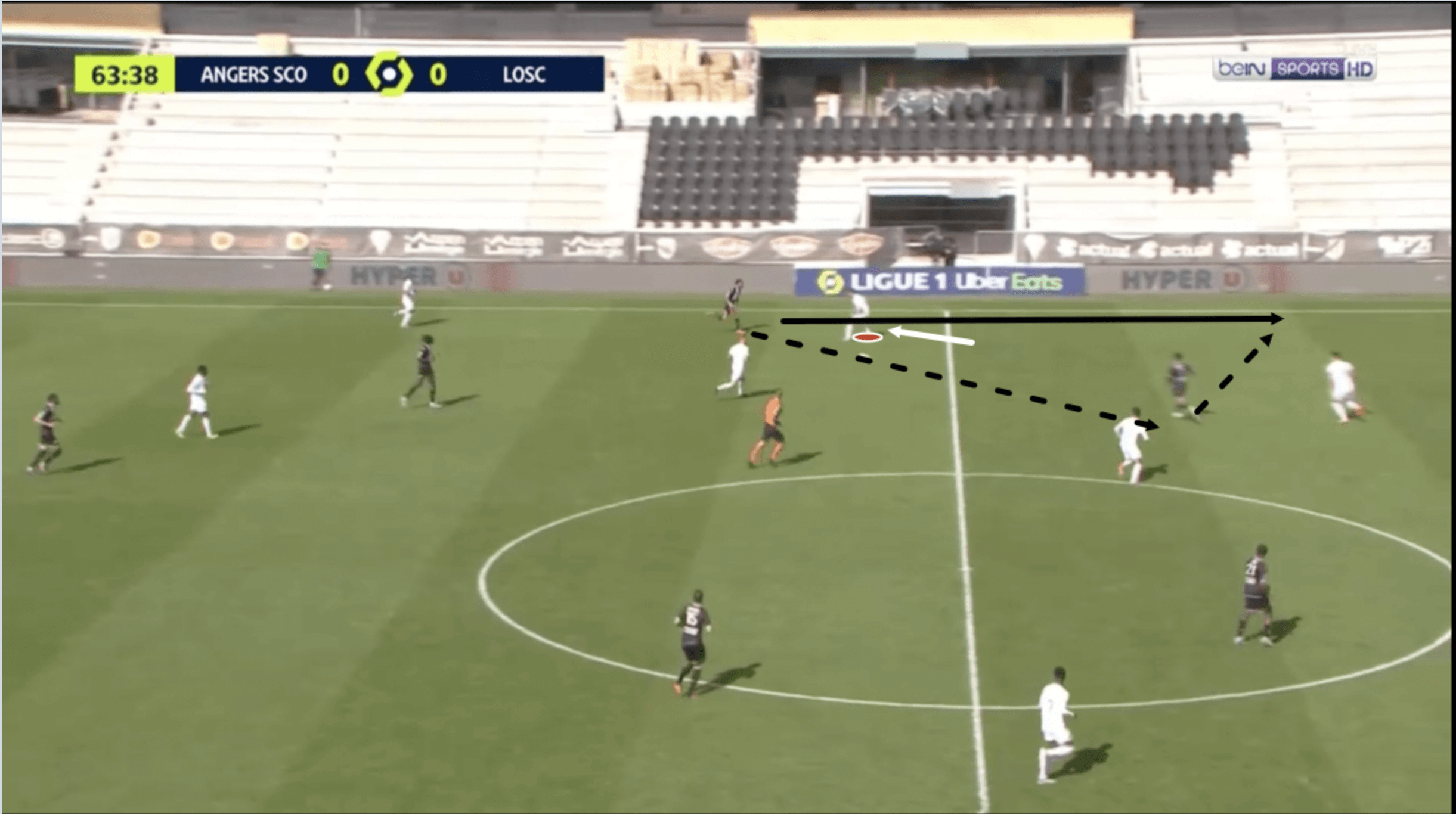
What relevance does this have for the backline? Well, if the first line of pressure gets beat (and gets beat early) then that can leave the backline more exposed, which is what happened in figure 4, for example. Here, the opposition made it past Lille’s first line of defence, leading to the winger becoming isolated 1v1 with Lille’s right-back. The right-back gets caught in a difficult situation — having to decide between jumping to engage in the 1v1 and focusing on protecting the space behind him and remaining compact with the centre-backs.
We’ve seen Zeki Çelik get forced to act very aggressively this season as a result of this, which we also see in figure 4. However, the right-back can’t defend all this space on his own and the opposition manage to get around him quite easily via a quick one-two, with the initial ball carrier ending up bursting past the right-back after sending the ball inside, enabling himself to collect the ball again after getting past the right-back to exploit the space in behind. From here, there are endless possibilities. The ball carrier could drag the centre-back out wide, creating more space centrally or engaging in a 1v1 that he could win and then overload Lille in their box or he could gallop away into this space between the defenders and progress his side into a far more advantageous position than the one in which he initially picked up the ball.
It’s been very common to see teams targeting this space in 2021/22 and hurting Lille from there. As a result, firstly, I’d say Lille need to get more organised and if it is pressing more aggressively that they’re committing to, then really get that perfected on the training ground over the summer or if they want to move back to playing as they were in their title-winning campaign, then rediscover the organisation they had that enabled them to successfully play that way. Right now, there isn’t enough organisation either way and the press appears disjointed, leading to deeper players being exposed far too often.
Lille need a right centre-back who’s comfortable with defending aggressively, including moving into wide areas and covering there when required, at least as backup for the ageing Fonte. Meanwhile, they also require an aggressive, reliable right-back. Lille like their full-backs to get forward as an option on the overlap quite frequently as well, so some ability going forward would also be desirable though this, admittedly, may only be as a backup option for Zeki Çelik. As a result of that fact, perhaps looking to the academy and promoting Ismaïl Bouleghcha, who impressed for Lille in the UEFA Youth League last year, may be the best option. Clermont Foot’s Akim Zedadka is also set to become a free agent at the end of June and after his highly impressive Ligue 1 debut season, I’d recommend him to a lot of clubs, so if this move is feasible, it could be worth exploring.
Meanwhile, for centre-back, again, Lille could look to the academy and I’m admittedly struggling to come up with fantastic options (again, without going to the lengths of conducting a proper analysis designed to find Lille a new right centre-back, which could be a piece in and of itself). However, with Saint-Étienne getting relegated, perhaps Mickaël Nadé could be an option. The 23-year-old was one of few bright sparks for Les Verts last term but his limitations in possession are a worry for me. The Frenchman is, though, a good defender who would fit the criteria mentioned above, and I wouldn’t be surprised to see him return to Ligue 1 next season, though a season in Ligue 2 as a starter may not be terrible for him either.
Midfield
Lille play with a midfield two, with their primary midfield duo consisting of Renato Sanches and Benjamin André. I’ll assume Lille will want to stick with this for next term, though I wouldn’t be surprised if Gourvennec were open to the idea of moving to a 4-3-3, given how much Lille’s defensive shape has changed and moved into this direction during his tenure. Presuming Lille can retain the services of these two for next term, they should be seen as reliable starters.
André gives you just about everything you could ask from a central midfielder, engaging in the second-most defensive duels (9.96 per 90) of any Lille player this term and playing a fairly high number of progressive passes (7.77 per 90) when compared with other Ligue 1 midfielders. Sanches, on the other hand, offers a lot of quality on the ball and a great, press-resistant option for ball progression as well as a great asset in chance creation — especially from the half-spaces from where he likes to cross. Sanches has played a very high number of progressive passes (9.27 per 90) for a Ligue 1 midfielder in 2021/22.
As is evident from figures 2, 3 and 4, a lot is typically asked of Lille’s midfielders and they very much play a box-to-box role. When their team is pressing high, their marking ability is tested as they’re often tasked with getting closer to opposition men in midfield to ensure that if the ball does make its way to them, they don’t have space to turn and continue playing the ball forward from a dangerous position. All over the pitch, their work rate, anticipation and spatial awareness are frequently called into action in their role of protecting their defensive line, covering for their forward line and guarding the middle of the pitch to ensure nothing makes its way through them there.
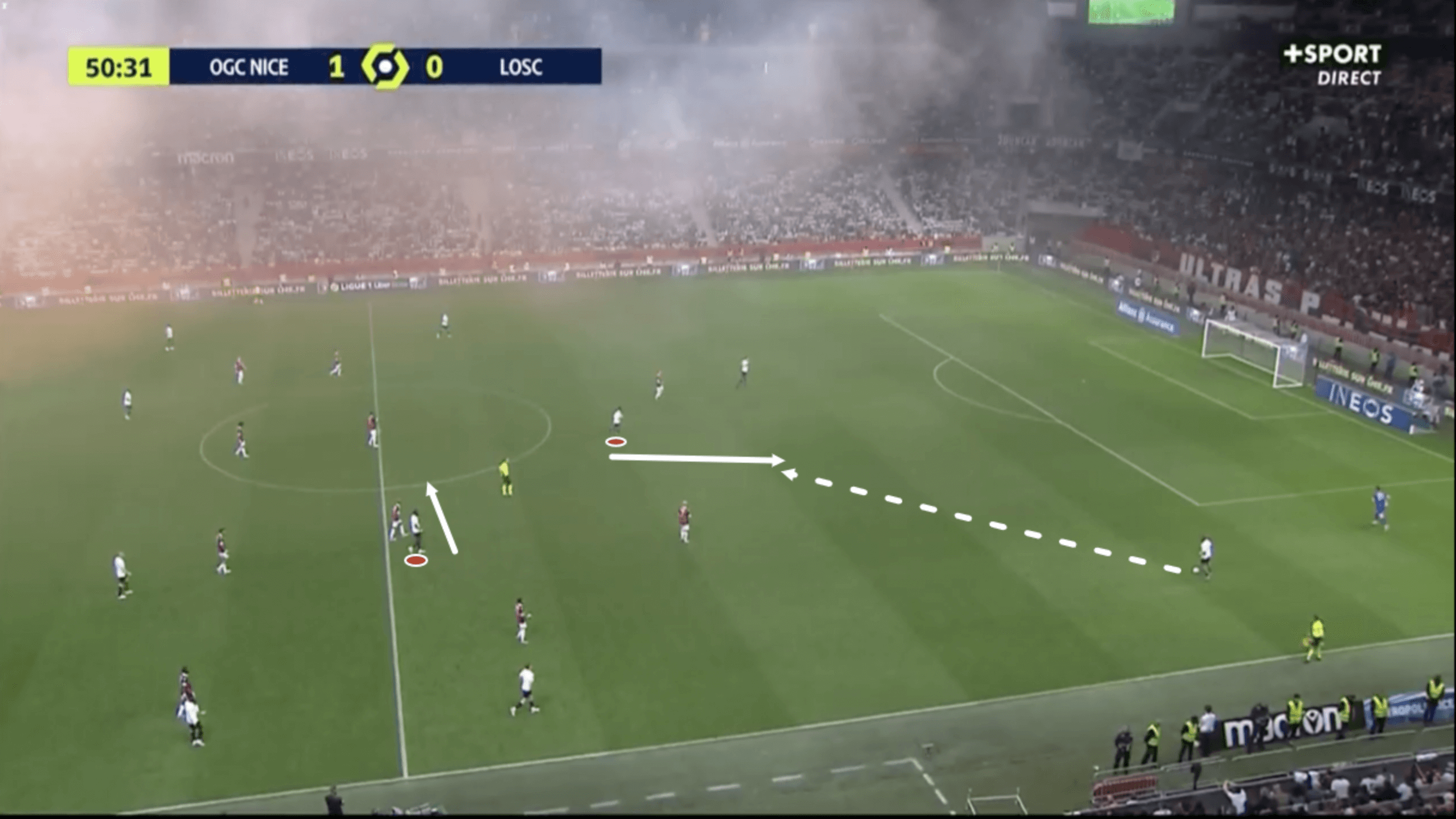
In possession, the primary objectives in earlier phases, as we see in figure 5, are creating a stagger to make themselves easier to find, harder to mark and easier for each other to play with, making themselves available for the centre-backs to find behind the opposition’s first line of pressure, and then turning to play the ball forward. It’s very common to see Sanches take on the role of dropping deeper in the earlier phases of play due to his press resistance and ability to create from deep. André is also comfortable with dropping deeper as he is extremely comfortable operating under pressure too and represents a very good progressive passing option. Both men are comfortable playing in the more advanced areas as well, with their press resistance again coming in handy here. Sanches represents a more creative option in these positions — expect to see him receive the ball, turn and create an opportunity to play through the opposition with flair and execute well. André isn’t the playmaker but is comfortable receiving in advanced areas and linking up with more creative teammates.
At the moment, replacing Xeka is of the utmost importance for Lille, so one midfield recruit to support André and Sanches is needed, at the very least. Clermont Foot’s Salis Abdul Samed is an interesting player who’s played regularly in a 4-2-3-1 this season. He’s not much of a ball progressor, I repeat, he’s not much of a ball progressor. From that perspective, perhaps he’s not the right profile here. However, from potential options that could provide Lille with backup and perhaps even compete with their midfield duo, I don’t think he’s the worst option around. In terms of ball retention, Samed is great. He’s proven very reliable in a deep midfield role this season at Clermont Foot for linking up with teammates and making himself available to help others escape pressure before then laying the ball off to someone else. He’s great at keeping the ball moving but others must then take the responsibility of progression for themselves. Additionally, though, Samed has a fantastic engine and offers everything Lille would want off the ball. With their midfielders becoming more and more exposed of late, perhaps this would make Samed and the skills he offers more desirable.
Additionally, this leaves the possibility open for Lille to perhaps change to a 4-2-3-1 or 4-3-3 themselves, allowing Samed to play with Sanches and André, which may beef their midfield up even more. There are probably better options out there, again, this wasn’t an extensive search of all options or anything, but I hope from this section the requirements for Lille’s midfield recruitment and some potential considerations they’ll need to make are clear.
Forward
The final section of this scout report will focus on Lille’s recruitment in the forward department. For me, we’ve left the biggest until last here as I believe replacing the departing Burak Yılmaz will undoubtedly be the most important job that Lille have this summer. Indeed, Yılmaz only spent two seasons at the club. However, his impact at Stade Pierre Mauroy, both in terms of the success that his presence helped to deliver and his crucial role within the team’s tactics, in those two seasons was such that replacing him would always inevitably be a tall order.
In Lille’s title-winning campaign, Yılmaz finished the season with +5.7 goals-minus-xG (per Statsbomb via FBRef) indicating significant overperformance. This past season, Lille paid for that as Yılmaz’s goals-minus-xG sat at -6.3 at the end of the campaign. The team actually continued to create as many chances as they did in the previous season, with their overall xG actually improving from 51.2 in 2020/21 to 54.04 in 2021/22. However, their goals dropped from 64 to 48, showing that while they were exceptional at taking their chances in the title-winning season, they weren’t good enough at doing so this past term.
I don’t think Lille have a major problem with chance creation but they can improve in the box and Yılmaz’s departure will represent an opportunity to do this. I believe this is where the majority of Lille’s transfer budget should be allocated this summer.
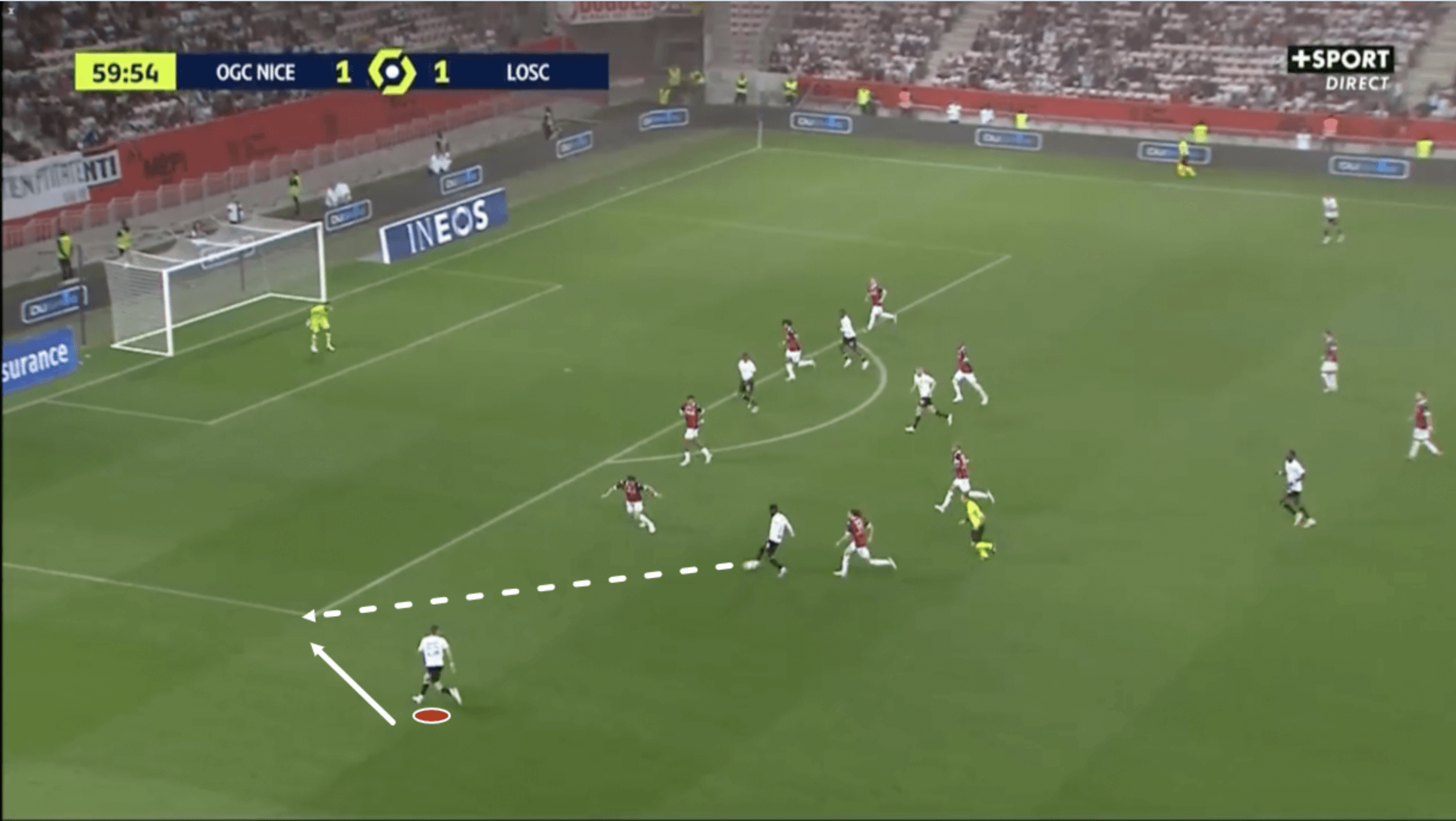
When entering the final third, Lille like to overload centrally and create width often via the full-backs but sometimes via the wingers too, Either way, a sight such as the one seen in figure 6 with the opposition being drawn very narrow before the ball is shot out wide to a teammate on the overlap is common for Gourvennec’s Lille. From here in figure 6, we see the wide man carry the ball further upfield and into a position from where he can square the ball to a teammate inside the box via a low cross.
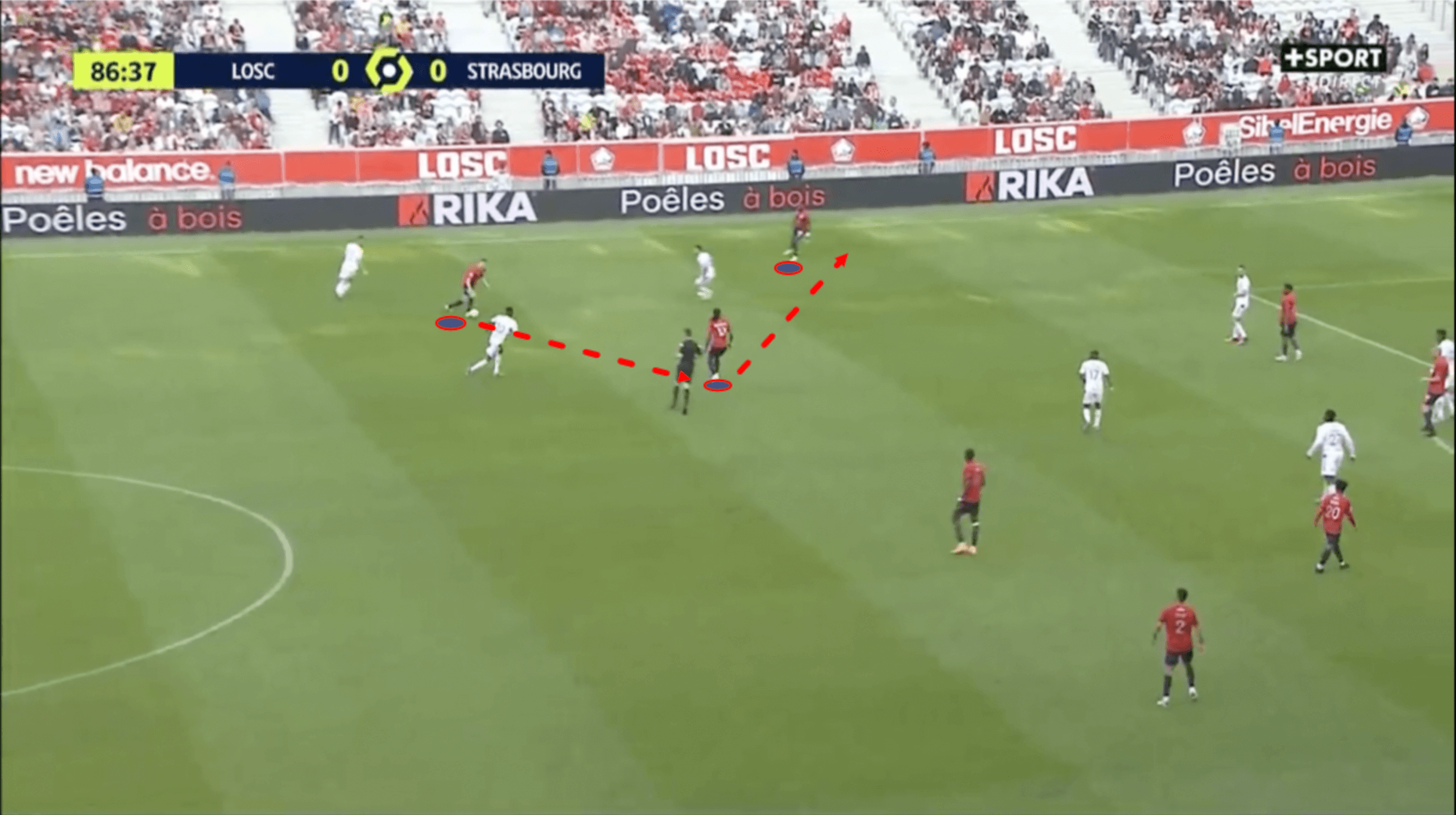
We see another example of Lille finding a way to use the width and get around the opposition full-back in figure 7. Here, the initial passing lane into the wide man was blocked by the opposition player who covered the passing lane with his positioning. However, Lille’s quick-thinking ball carrier found a way for his side to get around this by first sending the ball into midfield, allowing the midfielder to then play the wide man through into the final third. After this, the wide man was able to cut back onto his right foot and swing a high ball into the box for the attackers inside the area to compete for.
From both of these situations, we see how important the movement inside the box is for Lille’s forwards as they need to be in space at the right time to capitalise on the crossing opportunities their wide teammates create for them. Similarly, we see from figure 7, especially how important physicality is for Lille’s centre-forwards, as they must be able to contest aerial duels to capitalise on the early, high crosses their teammates send into the box for them. Physicality is also an important trait for the centre-forward Lille recruit this summer because in Jonathan David and Timothy Weah, they have pacey options that can get onto the end of flick-ons but they need a new Yılmaz to win those flick-ons. At the same time, the forward should be pacey and hard-working. We saw in the first section of analysis how the forwards are required to lead the press more aggressively under Gourvennec and also, the player should be able to offer his side an option in behind, whether that’s to give a deeper teammate like Sven Botman an option directly via the long ball or whether that’s to give the likes of David and Weah an option in behind for a well-timed through pass.
So, we’re looking for movement, physicality and work rate; one option in Ligue 1 that comes to mind for me is Strasbourg’s Habib Diallo. I’m convinced Diallo would be a very good option for Lille but he did play quite regularly for a Strasbourg side on the up and that qualified for UEFA Europa League football next season, so that, along with the fact the 26-year-old is tied down to a long-term contract, may make life difficult for Lille if they want to prise the forward away from their Ligue 1 rivals. However, Diallo didn’t start every game, with Ludovic Ajorque and Kévin Gameiro providing competition for places at Strasbourg. So, perhaps this is an option that could be explored, especially given that this could be Lille’s most important signing this summer. Again, I’m sure other options may be more feasible than a more in-depth analysis could uncover — the purpose of this is not to find the exact options, rather it’s to highlight the criteria that Lille need to be looking for and I hope this section has done that for Les Dogues’ attack.
Conclusion
To conclude this tactical analysis piece, I feel Lille could add an aggressive right-back comfortable with defending 1v1, a physical, agile and pacey right centre-back comfortable with defending in wide areas, a capable in-possession, defensively solid central midfielder and a positionally-astute, physical and hard-working centre-forward to their ranks for next season, via either the academy or the transfer market. I hope that this analysis has provided enthusiasts of Ligue 1 and of Lille with some food for thought regarding what the club will need to do to get back to competing towards the higher end of the table for next season via tactical analysis of Gourvennec and the team’s performance in 2021/22.





Comments